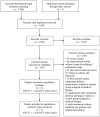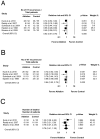Meta-analysis of catheter ablation as an adjunct to medical therapy for treatment of ventricular tachycardia in patients with structural heart disease
- PMID: 21147263
- PMCID: PMC3065522
- DOI: 10.1016/j.hrthm.2010.12.015
Meta-analysis of catheter ablation as an adjunct to medical therapy for treatment of ventricular tachycardia in patients with structural heart disease
Abstract
Background: Most studies of catheter ablation for the treatment of ventricular tachycardia (VT) are relatively small observational trials.
Objective: The purpose of this study was to define the relative risk of VT recurrence in patients undergoing catheter ablation as an adjunct to medical therapy versus medical therapy alone in a pooled analysis of controlled studies.
Methods: Randomized and nonrandomized controlled trials of patients who underwent adjunctive catheter ablation of VT versus medical therapy alone were sought. MEDLINE, EMBASE, the Cochrane central register of controlled trials (CENTRAL), and Web of Science were searched from 1965 to July 2010. Supplemental searches included Internet resources, reference lists, and reports of arrhythmia experts. Three authors independently reviewed and extracted the data regarding baseline characteristics, ablation methodology, medical therapy, complications, VT recurrences, mortality, and study quality.
Results: Five studies were included totaling 457 participants with structural heart disease. Adjunctive catheter ablation was performed in 58% of participants, whereas 42% received medical therapy alone for VT. Complications of catheter ablation included death (1%), stroke (1%), cardiac perforation (1%), and complete heart block (1.6%). Using a random-effects model, a statistically significant 35% reduction in the number of patients with VT recurrence was noted with adjunctive catheter ablation (P<.001). There was no statistically significant difference in mortality.
Conclusions: Catheter ablation as an adjunct to medical therapy reduces VT recurrences in patients with structural heart disease and has no impact on mortality.
Copyright © 2011 Heart Rhythm Society. Published by Elsevier Inc. All rights reserved.
Figures


References
-
- Moss AJ, Zareba W, Hall WJ, et al. Prophylactic implantation of a defibrillator in patients with myocardial infarction and reduced ejection fraction. N Engl J Med. 2002;346(12):877–83. - PubMed
-
- Bardy GH, Lee KL, Mark DB, et al. Amiodarone or an implantable cardioverterdefibrillator for congestive heart failure. N Engl J Med. 2005;352(3):225–37. - PubMed
-
- Kamphuis HC, de Leeuw JR, Derksen R, Hauer RN, Winnubst JA. Implantable cardioverter defibrillator recipients: quality of life in recipients with and without ICD shock delivery: a prospective study. Europace. 2003;5(4):381–9. - PubMed
-
- Hohnloser SH, Kuck KH, Dorian P, et al. Prophylactic use of an implantable cardioverter-defibrillator after acute myocardial infarction. N Engl J Med. 2004;351(24):2481–8. - PubMed
-
- Goldenberg I, Moss AJ, Hall WJ, et al. Causes and consequences of heart failure after prophylactic implantation of a defibrillator in the multicenter automatic defibrillator implantation trial II. Circulation. 2006;113(24):2810–7. - PubMed
Publication types
MeSH terms
Substances
Grants and funding
LinkOut - more resources
Full Text Sources
Medical

